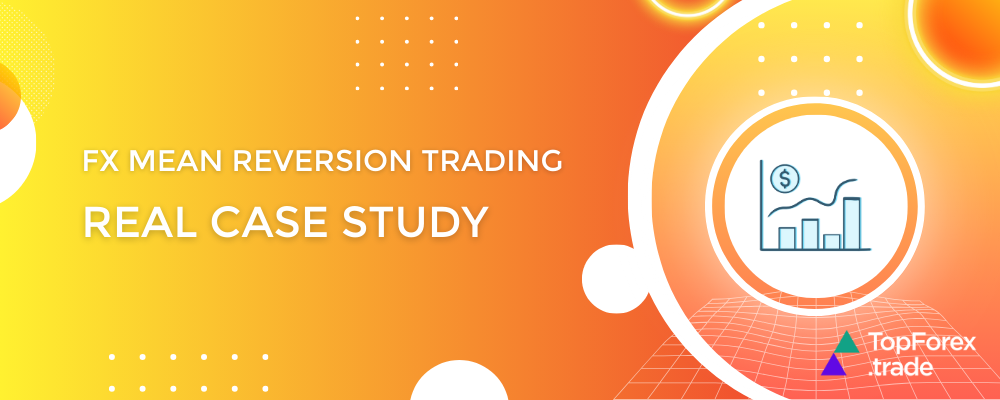How to trade Forex mean reversion and find the best brokers

Mean reversion is a popular Forex trading strategy based on the idea that prices tend to return to their average over time. Traders can capitalize on price corrections for profitable trades by identifying overbought or oversold conditions. In this guide, we’ll explain how mean reversion works, key indicators to use, and the best forex brokers that support this strategy.
❗ Looking for the best FX brokers for breakout trading? Just scroll down or check out our list of trusted brokers.
What is FX mean reversion?
Mean reversion is a trading strategy based on the assumption that prices tend to revert to their historical average after moving too far in either direction. The strategy focuses on identifying overbought or oversold conditions where price deviations from the mean are unsustainable, leading to a reversal.
This approach is widely used in Forex trading, as currency pairs often trade within ranges and return to equilibrium levels. Mean reversion works well in markets with no strong trends or when a trend temporarily overextends before correcting.
📌Core principles of mean reversion trading:
- Price deviation from the mean: If the price moves significantly above or below the historical average, it is likely to revert.
- Overbought and oversold levels: Extreme price levels suggest a reversion is due.
- Confirmation from technical indicators: Indicators like Bollinger Bands, RSI, and Moving Averages help confirm reversion signals.
- Risk management: Stop-loss and take-profit levels are essential to protect against unexpected price movements.
How mean reversion works in FX trading

To execute a mean reversion trade, follow these steps:
1. Identify the mean price level
The historical mean (average price) is determined using moving averages, Bollinger Bands, or regression analysis.
2. Detect overbought or oversold conditions
A price far above the mean is considered overbought, while a price significantly below the mean is oversold. Traders use indicators like the RSI and Bollinger Bands to identify these conditions.
3. Confirm reversal signals
Not every deviation from the mean results in a reversion. Confirmation signals (e.g., price rejecting a resistance level, divergence on RSI, or candle patterns) improve trade accuracy.
4. Enter the trade
- Short entry: If a currency pair is overbought and shows signs of reversal, traders open a sell position.
- Long entry: If a currency pair is oversold, traders enter a buy position.
5. Set stop-loss and take-profit levels
- Stop-loss: Placed beyond recent highs/lows to avoid false signals.
- Take-profit: Target is usually set at the mean price level or the opposite Bollinger Band.
Key technical indicators for mean reversion trading
1. Bollinger Bands (BB)
How it works:
- Bollinger Bands consist of a middle band (moving average) and two outer bands that expand or contract based on volatility.
- When the price touches or exceeds the upper band, it suggests overbought conditions.
- When the price touches the lower band, it signals oversold conditions.
Trading strategy:
- Short trade: If price moves above the upper Bollinger Band and shows signs of reversal, sell.
- Long trade: If price drops below the lower Bollinger Band and reverses, buy.
- Exit strategy: Close the trade when the price returns to the middle Bollinger Band (mean).
2. Relative Strength Index (RSI)
How it works:
- The RSI ranges from 0 to 100 and measures momentum.
- Readings above 70 indicate overbought conditions.
- Readings below 30 indicate oversold conditions.
Trading strategy:
- Short trade: If RSI is above 70 and starts to decline, enter a sell position.
- Long trade: If RSI is below 30 and rises, enter a buy position.
- Exit strategy: Close when RSI returns to 50 or a strong resistance/support level.
3. Moving Averages (MA)
How it works:
- Moving averages smooth price data and highlight mean price levels.
- The 50-day and 200-day moving averages are commonly used.
Trading strategy:
- If price moves significantly above the moving average, a reversion is likely.
- If price drops far below the moving average, it may soon rise.
- The crossover method (shorter MA crossing a longer MA) can also signal reversals.
4. Mean Reversion Oscillator (MRO)
How it works:
- Measures how far the price is from its mean.
- Similar to RSI, but focuses solely on mean reversion probabilities.
Trading strategy:
- Look for extreme values signaling an overextension from the mean.
- Combine with Bollinger Bands and RSI for confirmation.
Real case study: EUR/USD mean reversion trade

Scenario:
A FX trader spots an overbought EUR/USD setup:
- Price is trading 2.5% above its 50-day moving average.
- RSI is at 78, signaling overbought conditions.
- Price has breached the upper Bollinger Band.
Trade execution:
✅ Short entry: The trader opens a sell position when:
- RSI drops below 70.
- Price shows rejection at the resistance level.
✅ Stop-loss: Placed slightly above the recent high to avoid false breakouts.
✅ Take-Profit: Set at the 50-day moving average.
Outcome:
- Price reverts to the 50-day MA within three days.
- The trade yields a +2.5% profit.
- Confirmation from multiple indicators enhances trade reliability.
The best brokers for Forex mean reversion trading
What to look for in a FX broker?
- Tight spreads – Essential for short-term mean reversion trades.
- Fast execution – Delays can lead to missed reversals.
- Advanced charting tools – Required for technical analysis.
- Low commissions – Frequent trading needs cost-effective conditions.
Top brokers for mean reversion trading
HF Markets FX mean reversion trading
- HF Markets: Offers tight spreads, fast execution, and support for automated trading.
AvaTrade FX mean reversion trading
- AvaTrade: Known for advanced tools like AvaTradeGO and MetaTrader platforms.
XTB FX mean reversion trading
- XTB: Offers comprehensive charting tools and a user-friendly platform.
XM FX mean reversion trading
- XM: Provides flexible leverage, ultra-low spreads, and MetaTrader support.
Plus500 FX mean reversion trading
- Plus500: Features a simple, intuitive trading platform with risk management tools.
82% of retail investor accounts lose money when trading CFDs with this provider. You should consider whether you can afford to take the high risk of losing your money.
Related articles:
Forex mean reversion trading - FAQ